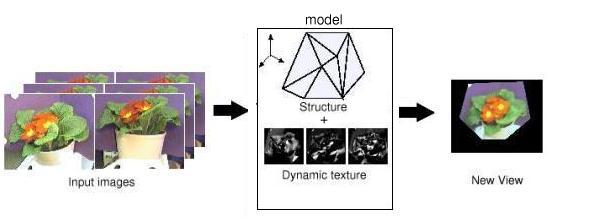In the following pages you will find an informal, but detailed overview of the internal workings and motivation of the system.
Capturing and modeling real-world scenes and objects from video alone
is a long standing problem in computer vision and graphics. Unlike
active methods (such as laser range finders), video-based methods
allow quick and non-intrusive capture using inexpensive commodity
cameras (e.g. web cams, digital cameras or camcorders) and a consumer
PC is sufficient for the processing and rendering.
In our method uncalibrated video from different views of an object or
scene are compiled into a geometry and texture model. The geometric
modeling is based on recent results in non-Euclidean multiview
geometry, and the texture is represented using a novel texture basis
capturing fine scale geometric and light variation over the
surface. During rendering view dependent textures are blended from
this basis and warped onto the geometric model to generate new views.

A visual breakdown of the process.
On this web site you can find both details on the theory as well as
downloads of a working system and some sample models. The system is
capable of frame rate rendering by performing the calculation
intensive code either (depending on your installed HW) on the CPU
through MMX SIMD extensions on the graphics card using NVIDIA register
combiners. Rendering and viewing of models is easy to set up and use
on either Windows or Linux PCs. The software for capturing and
processing video into models currently only runs under Linux and is
somewhat more complex to install, but it is doable for someone with
intermediate knowledge on how to configure Linux for digital video.


